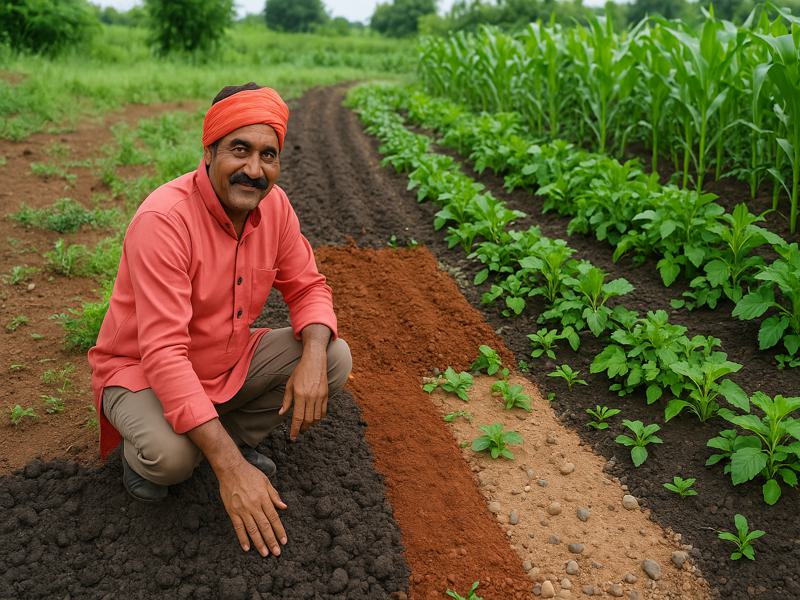Soil and Crop Management

Soil and Crop Management: Boosting Farm Productivity the Smart Way
In Indian agriculture, Soil and Crop Management plays a key role in increasing yield, improving soil health, and ensuring sustainable farming. Whether you’re growing rice in Punjab or millets in Maharashtra, understanding your soil and managing your crops effectively is essential for long-term success.
Soil is not just dirt under our feet — it is a living, breathing ecosystem that feeds the crops we grow. Likewise, choosing the right cropping methods can preserve that soil, making it more productive year after year. In this blog, we’ll dive deep into the types of soil in India, crop rotation and intercropping, the use of fertilizers and manure, and most importantly, how to maintain soil fertility.
Let’s cultivate knowledge, just like we cultivate our fields!
1. Types of Soil in India: Know Your Land
Understanding soil types is the first step toward better soil and crop management. India has diverse climatic conditions and geological formations, which lead to different soil types. Here are the most commonly found soils:
1.1. Black Soil
- Found in: Maharashtra, Madhya Pradesh, Gujarat
- Rich in: Iron, lime, calcium, potassium, magnesium
- Best for: Cotton, soybeans, pulses, millets
- Specialty: High moisture retention capacity
1.2. Red Soil
- Found in: Tamil Nadu, Karnataka, Andhra Pradesh, Odisha
- Rich in: Iron
- Low in: Nitrogen, phosphorus
- Best for: Groundnut, millets, potato, and pulses
- Specialty: Porous and easy to cultivate
1.3. Alluvial Soil
- Found in: Indo-Gangetic plains (Punjab, Uttar Pradesh, Bihar, West Bengal)
- Rich in: Potash, lime, phosphoric acid
- Best for: Wheat, rice, sugarcane, oilseeds
- Specialty: Extremely fertile and suitable for a wide range of crops
1.4. Laterite Soil
- Found in: Hilly areas of Kerala, Maharashtra, and North-East states
- Rich in: Iron and aluminium
- Best for: Tea, coffee, cashew
- Specialty: Needs proper fertilization to yield good crops
1.5. Desert Soil
- Found in: Rajasthan and parts of Haryana
- Rich in: Phosphates
- Low in: Humus and moisture
- Best for: Bajra, pulses (with irrigation)
Knowing your soil type helps you plan the right cropping strategy, fertilization, and irrigation methods.
2. Crop Rotation and Intercropping: Smarter Farming Techniques
2.1. Crop Rotation
Crop Rotation is the practice of growing different types of crops on the same land in a planned sequence over different seasons.
Benefits:
- Prevents pest and disease cycles
- Improves soil structure and fertility
- Balances nutrient use
- Enhances yield and quality
Example:
A popular Indian example is rotating rice with legumes like moong or urad dal to restore nitrogen in the soil.
2.2. Intercropping
Intercropping means planting two or more crops together on the same field in a specific pattern.
Benefits:
- Maximum utilization of land and sunlight
- Reduces weed growth
- Improves biodiversity
- Provides insurance against crop failure
Example:
Growing maize with beans or sugarcane with garlic is commonly practiced in Indian farms.
These traditional yet effective practices help in better soil and crop management while reducing dependence on chemical inputs.
3. Use of Fertilizers and Manure: Feeding the Soil, Not Just the Plants
3.1. Fertilizers
Fertilizers are chemical-based products rich in essential nutrients like nitrogen (N), phosphorus (P), and potassium (K).
Advantages:
- Quick nutrient supply
- Boosts crop growth
- Easy to apply
Disadvantages:
- Overuse harms soil health
- Risk of water pollution
Best Practice: Use recommended doses and combine them with organic options.
3.2. Manure
Manure is organic matter like cow dung, compost, or green manure added to soil to improve its fertility.
Advantages:
- Enhances soil texture
- Improves microbial activity
- Increases water retention
Green Manure Tip: Grow crops like dhaincha or sunhemp and plough them into the soil before flowering — it adds nitrogen naturally.
For balanced farming, a mix of both organic manure and chemical fertilizers is recommended under Integrated Nutrient Management (INM).
4. Maintaining Soil Fertility: Long-Term Gains
Maintaining soil fertility ensures long-term productivity without degrading natural resources. Here’s how you can do it:
4.1. Soil Testing
- Regular soil testing helps identify nutrient deficiencies and tailor fertilization accordingly. It avoids overuse and underuse.
- 👉 Soil Health Card Scheme – Government of India
- This initiative provides farmers with information about the nutrient status of their soil.
4.2. Use of Cover Crops
- Plants like clover or mustard are grown between crop seasons. They prevent erosion and add organic matter to the soil.
4.3. Avoiding Monoculture
- Repeatedly growing the same crop can exhaust specific nutrients. Diversify your cropping pattern to allow the soil to recover.
4.4. Adoption of Organic Farming
- Reduce the use of chemical inputs. Adopt natural pest control and biofertilizers to improve sustainability.
4.5. Proper Irrigation Techniques
- Over-irrigation leads to waterlogging and salt build-up. Drip or sprinkler irrigation methods reduce water wastage and protect soil structure.
Government Support for Farmers
- India has launched various schemes to promote good farming practices and soil health. One such platform is:
- Here, you’ll find schemes related to fertilizers, crop insurance, soil health cards, and more — helping farmers make informed decisions.
Read More from Our Blog
- 👉 Understanding Subsistence Farming in India
- Explore how traditional farming sustains rural communities and complements modern practices like crop rotation.
Conclusion: Let’s Grow Better, Not Just More
- To succeed in farming today, knowledge is as important as seeds and water. Effective soil and crop management is the cornerstone of sustainable agriculture. From understanding types of soil, practicing crop rotation and intercropping, to using fertilizers and manure wisely, and maintaining long-term soil fertility — every small action can result in higher productivity and healthier soil.
- Farming is not just about growing crops. It’s about growing with wisdom.
